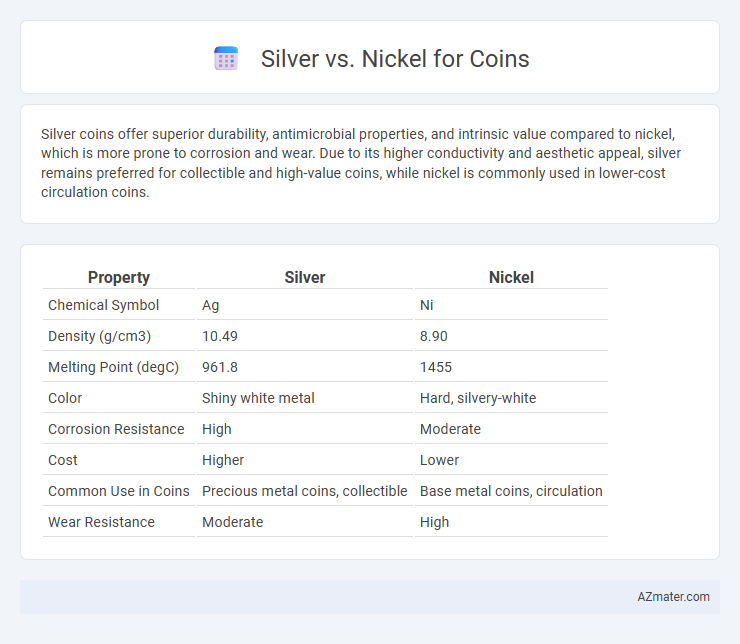Silver coins offer superior durability, antimicrobial properties, and intrinsic value compared to nickel, which is more prone to corrosion and wear. Due to its higher conductivity and aesthetic appeal, silver remains preferred for collectible and high-value coins, while nickel is commonly used in lower-cost circulation coins.
Table of Comparison
| Property | Silver | Nickel |
|---|---|---|
| Chemical Symbol | Ag | Ni |
| Density (g/cm3) | 10.49 | 8.90 |
| Melting Point (degC) | 961.8 | 1455 |
| Color | Shiny white metal | Hard, silvery-white |
| Corrosion Resistance | High | Moderate |
| Cost | Higher | Lower |
| Common Use in Coins | Precious metal coins, collectible | Base metal coins, circulation |
| Wear Resistance | Moderate | High |
Introduction to Silver and Nickel in Coinage
Silver has been used in coinage for centuries due to its intrinsic value, durability, and resistance to corrosion, making it an ideal metal for both circulation and bullion coins. Nickel, a durable and corrosion-resistant base metal, became popular in coinage during the 19th and 20th centuries as a cost-effective alternative to silver, especially for lower denomination coins. The transition from silver to nickel in many coinages reflects economic shifts, metal availability, and the need for more wear-resistant, affordable coinage materials.
Historical Use of Silver vs. Nickel Coins
Silver has been historically favored for coinage due to its intrinsic value and durability, with examples such as the Spanish dollar and the American silver dollar dominating economies from the 16th to early 20th centuries. Nickel entered coin production in the late 19th century as a cost-effective alternative, notably in the U.S. Shield nickel introduced in 1866, providing lower-value circulation coins with high corrosion resistance. The transition from silver to nickel reflected evolving economic needs, balancing precious metal scarcity and the demand for durable, affordable coinage.
Physical Properties: Silver vs. Nickel
Silver exhibits higher electrical and thermal conductivity compared to nickel, while nickel offers superior hardness and corrosion resistance, making it more durable in harsh environments. Silver's luster and softness allow for detailed minting and ease of shaping, but it can tarnish over time, unlike nickel which maintains its finish longer without oxidation. The density of silver (10.49 g/cm3) is significantly greater than nickel (8.90 g/cm3), influencing coin weight and feel during handling.
Durability and Wear Resistance
Silver coins offer moderate durability but tend to wear down faster due to silver's softness and malleability, leading to surface scratches and loss of detail over time. Nickel is significantly harder and more wear-resistant, making nickel coins better suited for circulation where durability is essential. The superior abrasion resistance and corrosion resistance of nickel alloys ensure longer-lasting coins with preserved designs.
Aesthetic Differences: Appearance and Tarnishing
Silver coins exhibit a bright, lustrous shine with a distinct white metallic hue that enhances their aesthetic appeal, while nickel coins display a duller, grayer tone with less reflectivity. Over time, silver coins develop a patina characterized by attractive black or blue-gray tarnish, which antique collectors often value for its vintage charm. Nickel coins tend to tarnish less noticeably, usually forming a greenish or brownish surface layer that can appear dull and degrade their visual appeal.
Economic Considerations: Cost and Availability
Silver coins historically carried intrinsic value due to the metal's high cost and limited availability, making them more expensive to produce than nickel coins. Nickel, being more abundant and less costly, offers a practical alternative for minting low-denomination coins with reduced production expenses. The fluctuating market prices for silver can lead to increased minting costs and potential coin hoarding or melting, while nickel's stable supply supports consistent economic feasibility in coin manufacturing.
Counterfeiting and Security Features
Silver coins possess inherent anti-counterfeiting advantages due to their unique luster, density, and thermal conductivity, which are difficult to replicate precisely. Nickel, while more abundant and cost-effective, lacks distinct physical properties, making coins more vulnerable to sophisticated counterfeit techniques without enhanced security features like micro-engraving or embedded holograms. The integration of advanced security elements in nickel-based coins compensates for the metal's lower intrinsic security, whereas silver's natural attributes provide a foundational deterrent against forgery.
Collectibility and Investment Value
Silver coins hold higher collectibility and investment value due to their intrinsic metal worth, historical significance, and widespread demand among collectors and investors. Nickel coins, while durable and low-cost for circulation, generally lack the precious metal content and rarity that drive long-term appreciation. Silver's market liquidity and appeal in numismatic circles make it a preferred choice for those seeking both tangible assets and collectible value.
Environmental and Health Impacts
Silver coins generate less environmental pollution during extraction compared to nickel, which involves extensive mining and smelting processes releasing harmful sulfur dioxide and heavy metals. Silver is less reactive and poses lower toxicity risks upon contact or inhalation, whereas nickel exposure frequently causes allergic reactions and respiratory issues in humans. Recycling silver from coins also demands less energy and produces fewer hazardous byproducts than nickel, making silver a more environmentally sustainable and health-conscious choice for coinage.
Conclusion: Choosing Between Silver and Nickel for Coins
Silver offers superior antimicrobial properties, corrosion resistance, and a higher intrinsic value compared to nickel, making it ideal for collectible or high-value coins. Nickel provides greater durability, lower cost, and resistance to wear, suited for everyday circulation and mass production. Selecting between silver and nickel depends on balancing cost-effectiveness with desired durability and aesthetic appeal in coin manufacturing.

Infographic: Silver vs Nickel for Coin
 azmater.com
azmater.com